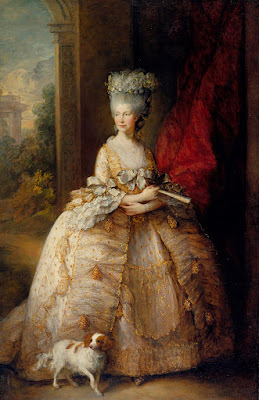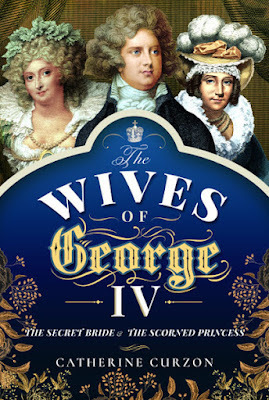Catherine Curzon's Blog, page 4
February 1, 2022
Fatal Fashion

A lady discovers that fashion can be deadly... literally. “A cutting wind or the fatal effects of tight-lacing”, c.1820, courtesy of the Bodleian Library, University of Oxford.
See more #gloriousGeorgians on Twitter!
January 10, 2022
Women in World War II: Tickets on Sale Now

As you may know, I co-write bestselling WWII sagas for Orion Dash as Ellie Curzon, with Helen Barrell. Helen and I are thrilled to be visiting the Huddersfield Literature Festival on 22nd March to talk about women in WWII, and tickets are available now.
Women in World War II
27th March, 2pm
During World War Two, many women had roles outside the home, from Land Girls and codebreakers to mechanics and Lumberjills.
In this lively and interactive illustrated talk, authors Catherine Curzon and Helen Barrell delve into the experiences of women away from the domestic front, including Yorkshire women who made an invaluable contribution to the war effort.
January 4, 2022
The Trouble with Rain

A fashion mishap for these intrepid #gloriousGeorgians! Chemise a la rain. Or an excellent shift for bad weather!!!, 1805, via the British Museum.
See more #gloriousGeorgians on Twitter!
December 16, 2021
The Codebreaker Girls: Out Today for 99p
 I'm thrilled to announce that our new WW2 saga, The Codebreaker Girls, is out in eBook and audiobook today. For a limited time only, the eBook is just 99p!
I'm thrilled to announce that our new WW2 saga, The Codebreaker Girls, is out in eBook and audiobook today. For a limited time only, the eBook is just 99p! ‘Saga lovers will really enjoy this book and i look forward to more’ NetGalley reviewer
‘What a fantastic read. This book pulled me in from the get go, so naturally was finished in one sitting’ NetGalley reviewer1944. Rosie Sinclair is full of pride to be doing her bit for the war effort as a driver at Cottisbourne Park – the secret heart of Britain’s fight against Germany, where a team of brilliant and eccentric codebreakers are battling to save the country.
But when she’s given a new mission to drive Major-General ‘Bluff’ Kingsley-Flynn down to Cottisbourne, Rosie finds herself on the frontline of a new battle – to uncover a possible spy at the Park who is jeopardising their vital work, and to resist her own growing attraction to the dashing Bluff himself…
As the threat to her fellow codebreaker girls grows ever stronger, Rosie realises her country needs her more than ever. Can she save the day without losing her heart?
A heartwarming, funny and utterly charming World War II saga, perfect for fans of Kate Hewitt, Jenny Holmes and Annie Murray.
December 8, 2021
Queen Charlotte's Christmas Tree

Most people believe that we have Prince Albert and Queen Victoria to thank for the tradition of Christmas trees in England, but that isn’t actually the case. In fact, for that particular tradition we should look thank and Queen Charlotte of Mecklenburg-Strelitz.
Charlotte put up the first known English tree at her home at the Queen’s Lodge, Windsor, in December, 1800. It was a tradition that she brought with her from Germany, where trees were a popular bit of festive decor. Legend has it that they were popularised by Martin Luther in 1536 who was strolling in a pine forest in Wittenberg one night when he glanced up through the canopy at the stars twinkling above him. Inspired, he hurried home and brought a fir red into his house, which he lit with candles. Luther hoped that this would remind his children of the heavens and, by extension, God.
Throughout the 17th century, trees of various types that were illuminated by candlelight became popular across Southern Germany whilst in Charlotte’s homeland of Mecklenburg-Strelitz, a single, mighty yew branch being decorated rather than a whole tree. Samuel Taylor Coleridge visited the country in 1799 and wrote of the traditions there. Among them, he noted, was the Yew branch.
"There is a Christmas custom here which pleased and interested me. The children make little presents to their parents, and to each other; and the parents to the children. For three or four months before Christmas the girls are all busy; and the boys save up their pocket money, to make or purchase these presents. What the present is to be is cautiously kept secret, and the girls have a world of contrivances to conceal it -- such as working when they are out on visits, and the others are not with them; getting up in the morning before daylight; and the like. then, on the evening before Christmas day, one of the parlours is lighted up by the children, into which the parents must not go.
A great yew bough is fastened on the table at a little distance from the wall, a multitude of little tapers are fastened in the bough, but so as not to catch it till they are nearly burnt out, and coloured paper hangs and flutters from the twings. Under this bough, the children lay out in great order the presents they mean for their parents, still concealing in their pockets what they intend for each other. Then the parents are introduced, and each presents his little gift, and then bring out the rest one by one from their pockets, and present them with kisses and embraces.
Where I witnessed this scene there were eight or nine children, and the eldest daughter and the mother wept aloud for joy and tenderness; and the tears ran down the face of the father, and he clasped all his children so tight to his breast, it seemed as if he did it to stifle the sob that was rising within him. I was very much affected.
The shadow of the bough and its appendages on the wall, and arching over on the ceiling, made a pretty picture, and then the raptures of the very little ones, when at last the twings and their needles began to take fire and snap! -- Oh, it was a delight for them! On the next day, in the great parlour, the parents lay out on the table the presents for the children; a scene of more sober joy success, as on this day, after an old custom, the mother says privately to each of her daughters, and the father to his sons, that which he has observed most praiseworthy, and that which was most faulty in their conduct.
Formerly, and still in all the smaller towns and villages throughout North Germany, these presents were sent by all the parents to some one fellow, who in high buskins, a white robe, a mask, and an enormous flax wig, personate Knecht Rupert, the servant Rupert. On Christmas night he goes round to every house, and says that Jesus christ his master sent him thither, the parents and elder children receive him with great pomp of reverence, while the little ones are most terribly frightened.
He then inquires for the children, and, according to the character which he hears from the parent, he gives them the intended presents, as if they came out of heaven from Jesus Christ. Or, if they should have been bad children, he gives the parents a rod, and in the name of his master recommends them to use it frequently. About seven or eight years old the children are let into the secret, and it is curious to observe how faithfully they keep it."
Charlotte was devoted to her homeland and when she came to England as a bride, she brought many traditions with her. Among them was the traditional Christmas yew branch and Charlotte used the tradition as a way to bring the royal household. She and her ladies-in-waiting positioned and decorated the bough in the centre of the Queen’s House’s largest room. As evening fell and the tapers were lit, the court assembled around the yew and sang carols. Then, by the light of the tree, they exchanged opulent gifts to celebrate Christmas.
This was the first, but not the last notable Christmas foliage of the Georgian era.
In 1800, Queen Charlotte was planning a Christmas Day party for the children of the most important and wealthy families in Windsor - I should say that the poor weren't forgotten either, and the 60 poorest families were given an enormous Christmas lunch too. This time, however, there would be no yew bow, but a whole tree. From it were hung the traditional decorations as well as small gifts for the children from the royal family. The children were enchanted by the sight before them, for they had never seen anything like it before. It glittered with glass and crystal and the scent of fruit and spice filled the drawing room, capturing the heart and imagination of all who saw it.
Dr John Watkins, one of the adults present, wrote:
"Sixty poor families had a substantial dinner given them and in the evening the children of the principal families in the neighbourhood were invited to an entertainment at the Lodge. Here, among other amusing objects for the gratification of the juvenile visitors, in the middle of the room stood an immense tub with a yew tree placed in it, from the branches of which hung bunches of sweetmeats, almonds and raisins in papers, fruits and toys most tastefully arranged and the whole illuminated by small wax candles. After the company had walked round and admired the tree, each child obtained a portion of the sweets which it bore together with a toy, and then all returned home quite delighted."
Thanks to the queen, the fashionable world raced to put up their Christmas trees and no one who fancied themselves anyone went without. Across high society trees were soon glittering in the most opulent drawing rooms in Britain.
So, when the adoring Prince Albert first put up his tree, he really was following in the footsteps of the glorious Georgians. Far from being first to the show, he was actually one of the last!
December 2, 2021
The Wives of George IV: Out Now
 I'm thrilled to report that my new book, The Wives of George IV: The Secret Bride & the Scorned Princess, is out now from Pen & Sword Books. It's available from this link, or your favourite bookshop!
I'm thrilled to report that my new book, The Wives of George IV: The Secret Bride & the Scorned Princess, is out now from Pen & Sword Books. It's available from this link, or your favourite bookshop!In Georgian England, few men were more fashionable or more eligible than George, Prince of Wales. Wild, glamorous, and with a penchant for beautiful women, the heir to George III’s throne was a very good catch – or so it seemed.
The two women who married him might beg to differ. Maria Fitzherbert was a twice-widowed Roman Catholic with a natural aversion to trouble. When she married the prince in a secret ceremony conducted in her Mayfair sitting room, she opened the door on three decades of heartbreak. Cast aside by her husband one minute, pursued tirelessly by him the next, Maria’s clandestine marriage was anything but blissful. It was also the worst kept secret in England.
Caroline of Brunswick was George’s official bride. Little did she know that her husband was marrying for money and when she reached her new home in England, she found him so drunk that he couldn’t even walk to the altar. Caroline might not have her husband’s love, but the public adored her. In a world where radicalism was stirring, it was a recipe for disaster.
In The Wives of George IV: The Secret Bride & the Scorned Princess, Maria and Caroline navigate the choppy waters of marriage to a capricious, womanising king-in-waiting. With a queen on trial for adultery and the succession itself in the balance, Britain had never seen scandal like it.
November 23, 2021
La brillante toillete de la Déesse du Gout

“I don’t wear wigs, this is my hair.” In La brillante toillete de la Déesse du Gout, c.1775, a fashionable lady models a towering wig for her adoring macaroni as her maid prepares another!
Via the British Museum.
See more #gloriousGeorgians on Twitter!
November 10, 2021
History Hack
I had a wonderful time chatting to the folks from History Hack about the mistresses of George I and II. From rumours of murder to ghostly ravens and the grumpiest kings Hanover ever saw, it's all here!
November 2, 2021
A Dandy Cock

It's not easy being a dandy during a heatwave! A Dandy Cock in Stays or A New Thing for the Ladies, Isaac Cruikshank, 1818. #gloriousGeorgians from the British Museum.
See more #gloriousGeorgians on Twitter!
October 26, 2021
Lady Gorget

When fashionable ladies in military-inspired fashions joined their husbands at Coxheath Camp, their critics thought it would lead to nothing but scandal and trouble! Lady Gorget raising Recruits for Cox-Heath, Robert Dighton, 1781. Via the British Museum.
See more #gloriousGeorgians on Twitter!



